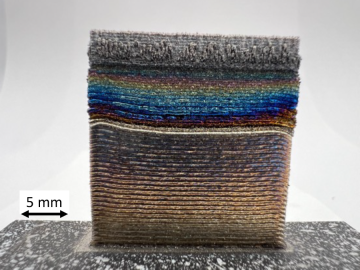
Filter News
Area of Research
- (-) Biology and Environment (56)
- (-) Materials (76)
- Advanced Manufacturing (1)
- Biological Systems (1)
- Building Technologies (1)
- Clean Energy (63)
- Computational Engineering (1)
- Computer Science (2)
- Electricity and Smart Grid (1)
- Energy Sciences (1)
- Fuel Cycle Science and Technology (1)
- Fusion and Fission (19)
- Fusion Energy (3)
- Isotope Development and Production (1)
- Isotopes (15)
- Materials Characterization (2)
- Materials Under Extremes (1)
- National Security (26)
- Neutron Science (32)
- Nuclear Science and Technology (2)
- Supercomputing (73)
News Topics
- 3-D Printing/Advanced Manufacturing (6)
- Advanced Reactors (1)
- Artificial Intelligence (3)
- Big Data (5)
- Bioenergy (18)
- Biology (24)
- Biomedical (3)
- Biotechnology (5)
- Buildings (3)
- Chemical Sciences (17)
- Clean Water (3)
- Climate Change (18)
- Composites (3)
- Computer Science (8)
- Coronavirus (4)
- Critical Materials (4)
- Decarbonization (13)
- Energy Storage (6)
- Environment (35)
- Exascale Computing (2)
- Frontier (2)
- Fusion (2)
- Grid (3)
- High-Performance Computing (10)
- Hydropower (3)
- Irradiation (1)
- Isotopes (3)
- Machine Learning (3)
- Materials (41)
- Materials Science (9)
- Mathematics (2)
- Mercury (2)
- Microscopy (5)
- Molten Salt (1)
- Nanotechnology (4)
- National Security (2)
- Net Zero (2)
- Neutron Science (8)
- Nuclear Energy (4)
- Partnerships (7)
- Physics (10)
- Polymers (4)
- Quantum Computing (2)
- Quantum Science (1)
- Renewable Energy (2)
- Simulation (13)
- Summit (2)
- Sustainable Energy (11)
- Transportation (3)
Media Contacts

Timothy Gray of ORNL led a study that may have revealed an unexpected change in the shape of an atomic nucleus. The surprise finding could affect our understanding of what holds nuclei together, how protons and neutrons interact and how elements form.

In the search for ways to fight methylmercury in global waterways, scientists at Oak Ridge National Laboratory discovered that some forms of phytoplankton are good at degrading the potent neurotoxin.

Mirko Musa spent his childhood zigzagging his bike along the Po River. The Po, Italy’s longest river, cuts through a lush valley of grain and vegetable fields, which look like a green and gold ocean spreading out from the river’s banks.

Since its inception in 2010, the program bolsters national scientific discovery by supporting early career researchers in fields pertaining to the Office of Science.

Dean Pierce of ORNL and a research team led by ORNL’s Alex Plotkowski were honored by DOE’s Vehicle Technologies Office for development of novel high-performance alloys that can withstand extreme environments.

Wildfires are an ancient force shaping the environment, but they have grown in frequency, range and intensity in response to a changing climate. At ORNL, scientists are working on several fronts to better understand and predict these events and what they mean for the carbon cycle and biodiversity.

Xiao-Ying Yu, a distinguished scientist at the Department of Energy’s Oak Ridge National Laboratory, has been named a Fellow of AVS: Science and Technology of Materials, Interfaces, and Processing, formerly American Vacuum Society.

Wildfires have shaped the environment for millennia, but they are increasing in frequency, range and intensity in response to a hotter climate. The phenomenon is being incorporated into high-resolution simulations of the Earth’s climate by scientists at the Department of Energy’s Oak Ridge National Laboratory, with a mission to better understand and predict environmental change.

Research into a new, unique technology to fabricate composite metal parts for a wide range of applications operating in extreme environments across the aviation, space and energy industries is showing promise for additive manufacturing.

Oak Ridge National Laboratory researchers developed a model framework that identifies ways to ensure wildlife can safely navigate their habitats while not unduly affecting infrastructure.


